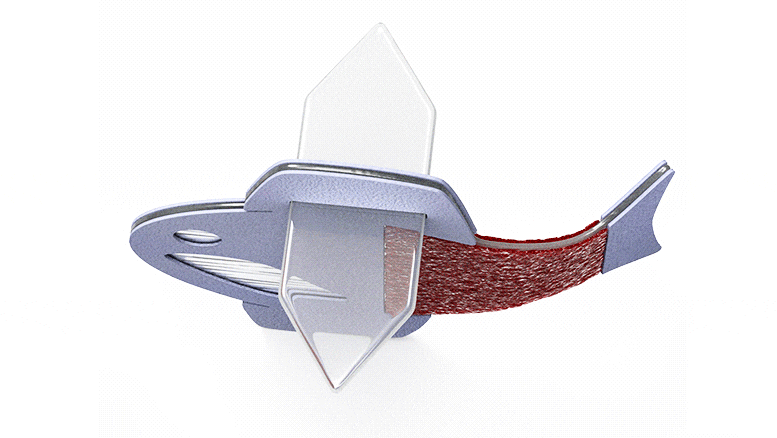
A fully autonomous biohybrid fish has been created using cardiac muscle cells derived from human stem cells.
Device offers insights into artificial muscular pumps, a step toward building an artificial heart.
Harvard University researchers, in collaboration with colleagues from Emory University, have developed the first fully autonomous biohybrid fish from human stem-cell derived cardiac muscle cells. The artificial fish swims by recreating the muscle contractions of a pumping heart, bringing researchers one step closer to developing a more complex artificial muscular pump and providing a platform to study heart disease like arrhythmia.
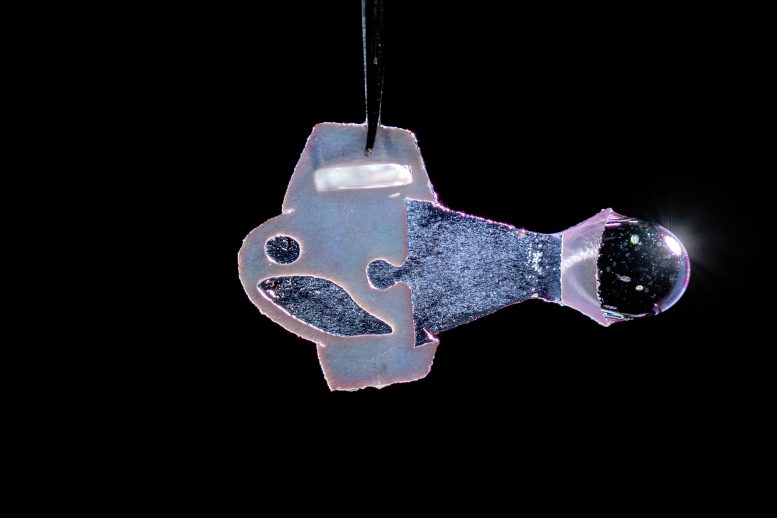
The first fully autonomous biohybrid fish from human stem-cell derived cardiac muscle cells. Credit: Michael Rosnach, Keel Yong Lee, Sung-Jin Park, Kevin Kit Parker
“Our ultimate goal is to build an artificial heart to replace a malformed heart in a child,” said Kit Parker, the Tarr Family Professor of Bioengineering and Applied Physics at the Harvard John A. Paulson School of Engineering and Applied Sciences (SEAS) and senior author of the paper. “Most of the work in building heart tissue or hearts, including some work we have done, is focused on replicating the anatomical features or replicating the simple beating of the heart in the engineered tissues. But here, we are drawing design inspiration from the biophysics of the heart, which is harder to do. Now, rather than using heart imaging as a blueprint, we are identifying the key biophysical principles that make the heart work, using them as design criteria, and replicating them in a system, a living, swimming fish, where it is much easier to see if we are successful.”
The research is published in Science.
The biohybrid fish developed by the team builds off previous research from Parker’s Disease Biophysics Group. In 2012, the lab used cardiac muscle cells from rats to build a jellyfish-like biohybrid pump and in 2016 the researchers developed a swimming, artificial stingray also from rat heart muscle cells.
In this research, the team built the first autonomous biohybrid device made from human stem-cell derived cardiomyocytes. This device was inspired by the shape and swimming motion of a zebrafish. Unlike previous devices, the biohybrid zebrafish has two layers of muscle cells, one on each side of the tail fin. When one side contracts, the other stretches. That stretch triggers the opening of a mechanosensitive protein channel, which causes a contraction, which triggers a stretch and so on and so forth, leading to a closed loop system that can propel the fish for more than 100 days.
This is the first autonomous biohybrid device made from human stem-cell derived cardiomyocytes. This device was inspired by the shape and swimming motion of a zebrafish. Unlike previous devices, the biohybrid zebrafish has two layers of muscle cells, one on each side of the tail fin. When one side contracts, the other stretches. That stretch triggers the opening of a mechanosensitive protein channel, which causes a contraction, which triggers a stretch and so on and so forth, leading to a closed loop system that can propel the fish for more than 100 days. Credit: Keel Yong Lee, Sung-Jin Park, David G. Matthews, George Lauder, Kevin Kit Parker
“By leveraging cardiac mechano-electrical signaling between two layers of muscle, we recreated the cycle where each contraction results automatically as a response to the stretching on the opposite side,” said Keel Yong Lee, a postdoctoral fellow at SEAS and co-first author of the study. “The results highlight the role of feedback mechanisms in muscular pumps such as the heart.”
The researchers also engineered an autonomous pacing node, like a pacemaker, which controls the frequency and rhythm of these spontaneous contractions. Together, the two layers of muscle and the autonomous pacing node enabled the generation of continuous, spontaneous, and coordinated, back-and-forth fin movements.
“Because of the two internal pacing mechanisms, our fish can live longer, move faster and swim more efficiently than previous work,” said Sung-Jin Park, a former postdoctoral fellow in the Disease Biophysics Group at SEAS and co-first author of the study. “This new research provides a model to investigate mechano-electrical signaling as a therapeutic target of heart rhythm management and for understanding pathophysiology in sinoatrial node dysfunctions and cardiac arrhythmia.”
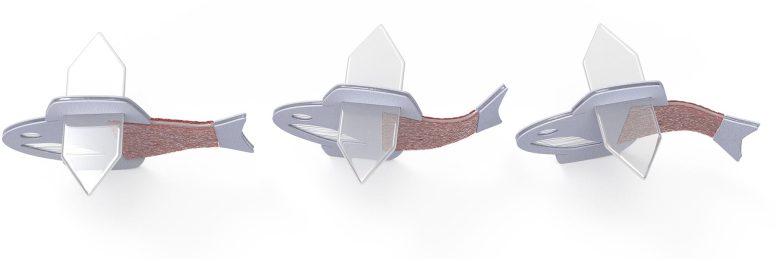
Schematics of autonomously swimming biohybrid fish. Credit: Michael Rosnach, Keel Yong Lee, Sung-Jin Park, Kevin Kit Parker
Park is currently an Assistant Professor at the Coulter Department of Biomedical Engineering at Georgia Institute of Technology and Emory University School of Medicine.
Unlike a fish in your refrigerator, this biohybrid fish improves with age. Its muscle contraction amplitude, maximum swimming speed, and muscle coordination all increased for the first month as the cardiomyocyte cells matured. Eventually, the biohybrid fish reached speeds and swimming efficacy similar to zebrafish in the wild.
Next, the team aims to build even more complex biohybrid devices from human heart cells.
“I could build a model heart out of Play-Doh, it doesn’t mean I can build a heart,” said Parker. “You can grow some random tumor cells in a dish until they curdle into a throbbing lump and call it a cardiac organoid. Neither of those efforts is going to, by design, recapitulate the physics of a system that beats over a billion times during your lifetime while simultaneously rebuilding its cells on the fly. That is the challenge. That is where we go to work.”
Reference: “An autonomously swimming biohybrid fish designed with human cardiac biophysics” by Keel Yong Lee, Sung-Jin Park, David G. Matthews, Sean L. Kim, Carlos Antonio Marquez, John F. Zimmerman, Herdeline Ann M. Ardoña, Andre G. Kleber, George V. Lauder and Kevin Kit Parker, 10 February 2022, Science.
DOI: 10.1126/science.abh0474
The research was co-authored by David G. Matthews, Sean L. Kim, Carlos Antonio Marquez, John F. Zimmerman, Herdeline Ann M. Ardona, Andre G. Kleber and George V. Lauder.
It was supported in part by National Institutes of Health National Center for Advancing Translational Sciences grant UH3TR000522, and National Science Foundation Materials Research Science and Engineering Center grant DMR-142057.

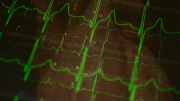


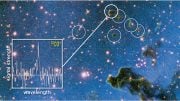
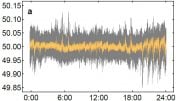
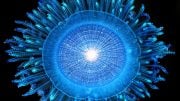


Babu G. Ranganathan*
(B.A. Bible/Biology)
HOW DOES DNA TURN A CELL INTO A FISH, OR A BIRD, OR A HUMAN?
When you divide a cake, the cake never gets bigger. However, when we were just a single cell and that cell kept dividing we got bigger. New material had to come from somewhere. That new material came from food.
Just as the sequence of various letters and words in human language communicate a message and direct workers to build and assemble something so, too, the sequence of various molecules in our DNA (our genes or genetic code) directed molecules (i.e. various amino acids, the building blocks of proteins) from our mother’s food, that we received in the womb, to become new cells, eventually forming all the tissues and organs of our body. Food isn’t just for energy. It’s also material used by the body to make new cells. After all, when we eat meat or vegetables we’re actually eating cells of animals and plants.
When you feed a cat your food the cat’s DNA will direct the food molecules to become the cells, tissues, and organs of a cat, but your DNA will turn the same food into human cells, tissues, and organs.
What we call “genes” are actually segments of the DNA molecule. When you understand how your DNA works, you’ll also understand how egg yolks can turn into chickens. Read my popular Internet article: HOW DID MY DNA MAKE ME? Just google the title to access the article.
This article will give you a good understanding of how DNA, as well as cloning and genetic engineering. You also learn that so-called “Junk DNA” isn’t junk at all. You will learn why it is not rational to believe that DNA code could have arisen by chance. Science points (not proves, but points) to an intelligent cause for DNA code.
What about genetic and biological similarities between species? Genetic information, like other forms of information, cannot happen by chance, so it is more logical to believe that genetic and biological similarities between all forms of life are due to a common Designer who designed similar functions for similar purposes. It doesn’t mean all forms of life are biologically related! Only genetic similarities within a natural species proves relationship because it’s only within a natural species that members can interbreed and reproduce.
Nature cannot build DNA code from scratch. It requires already existing DNA code to direct and bring about more DNA code or a genetic engineer in the laboratory using intelligent design and highly sophisticated technology to bring DNA code into existence from scratch. Furthermore, RNA/DNA and proteins are mutually dependent (one cannot come into existence without the other two) and cannot “survive” or function outside of a complete and living cell. DNA code owes its existence to the first Genetic Engineer – God!
Protein molecules require that various amino acids come together in a precise sequence, just like the letters in a sentence. If they’re not in the right sequence the protein won’t function. DNA and RNA require for various their various nucleic acids to be in the right sequence.
Furthermore, there are left-handed and right-handed amino acids and there are left-handed and right-handed nucleic acids. Protein molecules require for all their amino acids to be left-handed only and in the right sequence. DNA and RNA require for all their nucleic acids to be right-handed and in the right sequence. It would take a miracle for DNA, RNA, and proteins to arise by chance!
Mathematicians have said any event in the universe with odds of 10 to 50th power or greater is impossible! The probability of just an average size protein molecule (with its amino acids in the right sequence) arising by chance is 10 to the 65th power. Even the simplest cell is made up of many millions of various protein molecules along with and DNA/RNA..
The late great British scientist Sir Frederick Hoyle calculated that the odds of even the simplest cell coming into existence by chance is 10 to the 40,000th power! How large is this? Consider that the total number of atoms in our universe is 10 to the 82nd power.
Also, so-called “Junk DNA” isn’t junk. Although these “non-coding” segments of DNA don’t code for proteins, they have recently been found to be vital in regulating gene expression (i.e. when, where, and how genes are expressed, so they’re not “junk”). Also, there is evidence that, in certain situations, they can code for proteins through the cell’s use of a complex “read-through” mechanism.
Visit my latest Internet site: THE SCIENCE SUPPORTING CREATION (This site answers many arguments, both old and new, that have been used by evolutionists to support their theory)
Author of the popular Internet article, TRADITIONAL DOCTRINE OF HELL EVOLVED FROM GREEK ROOTS
*I have given successful lectures (with question and answer period afterwards) defending creation before evolutionist science faculty and students at various colleges and universities. I’ve been privileged to be recognized in the 24th edition of Marquis “Who’s Who in The East.”
How were the stem cells obtained?
Same way you get them when you kill baby.